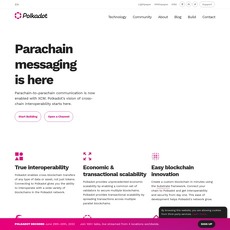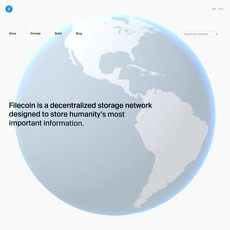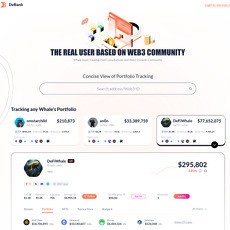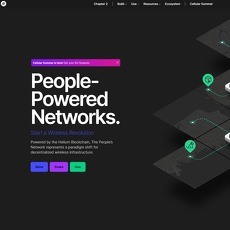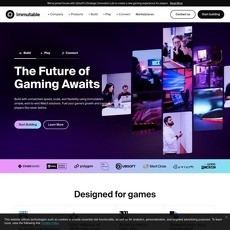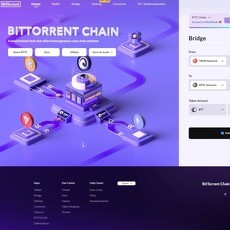Chainlink Review
Chainlink
chain.link
Chainlink: Full Website Review, Pros and Cons; Everything You Need to Know.
In recent times, Chainlink has earned quite a lot of interest. Perhaps, this is because chainlink has established a decentralized channel supported by the token LINK, which has survived staying afloat even through the gloomiest days of crypto winter, with the crucial goal of linking real-world data with smart contracts on the blockchain.
If you are a fan of real-world data, you’ll be a fan of chainlink. In the subsequent paragraphs, we’ll highlight some interesting details about chainlink
About Chainlink
Chainlink is a decentralized oracle platform that allows smart contracts to link with external data. Chainlink built a safe wall to safeguard decentralized applications from harmful attacks when they were easily compromised.
The Chainlink project aims to build a decentralized oracle system that is fully interoperable with blockchains like Bitcoin and Ethereum. Smart contracts on Chainlink serve various purposes, the first of which is reputation evaluation. An investor can use these contracts independently if they have a certain set of qualities, such as the reputation of all oracles and the ability to evaluate the service, which is known as a "Service Level Agreement."
When an oracle breaks the system's rules and provides misleading information, its reputation is lowered. You can start concluding agreements and delivering the requested details at the software level once the required number of off-net oracles has been selected. The contract, which is in the aggregating process, takes data from off-line oracles and then averages it to produce weighted aggregate responses.
Who controls the Chainlink website?
Chain.link is the official website of Chainlink. As indicated on the website, Chainlink is an open-source technology developed collaboratively by a broad community of developers, researchers, and users with the common objective of making Chainlink a public good for the whole blockchain ecosystem.
Who created Chainlink?
In September 2017, Steve Ellis, Ari Juels, and Sergey Nazarov published a white paper - this was how Chainlink began. Their vision for a decentralized oracle network was presented in the paper. Chainlink’s technology was created to address one of the most pressing issues with smart contracts on blockchains: delivering blockchains with reliable real-world data. The project began by providing smart contract services on Ethereum, but it has now extended to include other smart contract-capable blockchains.
Another for-profit fintech firm, SmartContract Chainlink Ltd., was created to administer Chainlink's technology, with Sergey Nazarov as CEO. The firm is located in the Cayman Islands. Chainlink technology is further being developed by a global developer and research team united under ChainlinkLabs.
Pro features of Chainlink
Most times, learning about the pro features of a network helps speed up the decision of joining or not. Some pro features of the network are outlined below.
● Traditional system
Common Chainlink applications deliver data to more traditional platforms, including websites, IoT networks, and data providers. Enterprises can also use Chainlink to make their data accessible to blockchain networks. Chainlink's oracles, which are blockchain agnostic, are the ideal integration gateway for connecting digital data or infrastructure to every blockchain.
The World Economic Forum lately received an industry-standard framework for utilizing the oracle network to link traditional systems. Chainlink may be the ideal solution for this standard.
● Gaming
Developers have recently started to release game apps based on smart contract technologies. A source of randomness for in-game events or determining the winner of a contest is one of the elements that most games require. The VRF solution from Chainlink provides the same kind of randomness required. It provides it to the smart contract so that it can be demonstrated to be fair and impartial because no one, including the developers, can interfere with the randomness.
● Threshold signatures
A new approach to using threshold signatures on Chainlink was a walk in this path, allowing the team to develop oracle networks with thousands of nodes.
The key advantage of this threshold signature structure is that it enables oracles to have their signatures checked on-chain, which increases security while also saving time.
● Smart contract input
Chainlink is attempting to become the greatest source of smart contract inputs and outputs, in addition to establishing efficient, safe, and highly decentralized oracle networks.
One of the objectives of getting to this point is to make smart contract development as quick as web app development is now. If the Chainlink team succeeds in reaching this goal, smart contract developers can draw from a collection of inputs and outputs, identical to how web developers may draw from a huge pool of APIs and data streams.
This would bring Chainlink the preferred blockchain for smart contracts and developers looking for pre-built inputs and outputs that can be quickly integrated into dApps, or that can securely and conveniently accept customized input/output requests.
● Trusted Execution Environment
When Chainlink bought Town Crier in late 2018, Trusted Execution Environments, or TEEs for oracles, were integrated into the platform.
Chainlink adds an extra degree of security for individual node operators by integrating TEEs with decentralized computations. TEEs can allow all computations conducted by a node private, including those performed by the node operator.
This improves the oracle network's general reliability by preventing any node from interfering with any computations they conduct.
● Oracle and source distribution
The concepts of oracle distribution and source distribution utilized by Chainlink demonstrate its decentralized nature and distinguish it from other oracle protocols. Chainlink can avert centralization and other security problems thanks to this decentralization.
The bases of the Oracle network's security and decentralization are the source and oracle distribution. Oracles get their data from several sources, thanks to the source distribution. This assists them in maintaining a positive network reputation. Oracle distribution, on the other hand, is the concept of contracting data requests to numerous oracles to ensure decentralization.
Furthermore, the Chainlink Network's growing portfolio of decentralized services is enabling innovation across several major blockchains by offering developers a variety of critical oracle functions:
● Chainlink VRF
Enables projects such as Aavegotchi to mint NFTs with provably unique features and PoolTogether to moderately choose winners in its no-loss lottery by generating checkable randomness backed by on-chain cryptographic proofs.
● Chainlink price feed
Provide a large database of on-chain financial market data for a wide range of assets, which protects billions of dollars for top DeFi apps like Aave, Synthetix, and dYdX.
● Chainlink external adapters
Provide developers the devices to connect to any off-chain resource or API, as used by Arbol's parametric crop insurance market to acquire meteorological data and Everpedia's prediction market users to get election results in the United States.
● Chainlink proof of reserve
Allows smart contracts to execute on-demand audits of tokenized asset reserves, like stablecoins such as TUSD and PAX and cross-chain tokens, by providing on-chain data feeds.
User concerns about Chainlink
No matter how much the pro features are, there will always be some areas of concern for the users. Some of the users' concerns about chainlink are listed below.
● Decentralizing the oracle network
The Chainlink team recognizes and is devoted to strengthening the decentralization of the oracle network as an area for improvement. Job specifications can be deployed by clients via the Chainlink client smart contract, leading to Job IDs being shared with other customers.
This implies that all data requests have a specified oracle that can answer them. This is a disadvantage of an early oracle network: there is presently no randomness or pure competition among oracles.
● Vulnerability to economic exploits
In September 2020, for instance, multiple Chainlink node operators were victims of a spam assault that led to the loss of 700 ETH from their wallets. The attack took advantage of how node operators responded to queries, Ethereum's high gas prices, and using a third token connected to network transaction costs. Although the attack was minor in scale, it demonstrates how nodes might be exploited for financial gain.
Where to buy Chainlink cryptocurrency?
Chainlink can be bought on various exchanges, including Bybit, with any verified account. LINK miners can earn tokens by selling off-chain services and data through a Chainlink-connected API.
In 2020 and 2021, Chainlink's crypto expanded significantly. Newbie traders may believe that the price of the cryptocurrency has greatly risen and that it is therefore too late to invest in it. Most experts, on the other hand, believe that Chainlink's advancement potential is still tremendous.
The argument is that Chainlink is different from simply speculative initiatives in that it is safer because it can generate significant returns. Long- and short-term investments are both suitable with cryptocurrency. Any crypto investor should have it.
How does the Chainlink support network work?
Chainlink uses a network of nodes to verify that the data provided to smart contracts are secure and trustworthy. A smart contract, for example, requires and requests real-world data. LINK records the requirement and transmits it to the Chainlink nodes network for bidding.
LINK verifies the data from several sources once the request is submitted, which makes this method reliable. Due to its internal reputation function, the protocol can identify trustworthy sources with a high degree of precision. Such a feature enhances the likelihood of greater accuracy while preventing smart contracts from being attacked.
For their services, smart contracts that request data pay node operators in LINK, Chainlink's native token. The price is decided by the node operators based on the market value and conditions of the data.
Furthermore, node operators stake the network to assure long-term commitment and trust in the project. Smart contracts encourage Chainlink node operators to perform consistently rather than destroy the platform.
How does Chainlink's native token work?
Data purchasers and buyers who pay for translated data into the blockchain utilize the LINK token. During bidding, data vendors or oracles determine the price of such services. LINK is an ERC677 token that works with an ERC-20 token, letting it understand data payloads.
You can invest in LINK by pressing the icon provided below, even if you earn the token as the data provided. Even though Chainlink previously operated on the Ethereum blockchain, blockchains like Hyperledger and Bitcoin tend to use LINK's oracle services.
The blockchains can trade data to the Chainlink network as node operators and be paid in LINK in the technique. After Uniswap, the coin ranks second on the DeFi chart with a full supply of one billion LINK tokens.
Frequently Asked Questions (FAQs)
Is Oracle the creator of Chainlink?
Oracle Corp. (ORCL) is a computer technology firm specializing in database management. Oracle Corporation is not related to Chainlink. Chainlink describes itself as a decentralized oracle network, with the "oracle" referring to a large group of intermediates who connect blockchains to off-chain information sources.
What is “real-world data”?
Real-world data, also referred to as off-chain data or external data, denotes the present global data architecture that occurs outside of the blockchain and must be brought on-chain through oracles for smart contract applications to access it. Blockchain-based smart contracts, like computers without the Internet, have intrinsic value in and of themselves, such as the creation and trading of tokens. Nevertheless, externally connected to the massive and increasing data and API economy taking root outside the blockchain environment, they become excessively more dominant.
Are Chainlink transactions anonymous? Can chainlink be traced?
The Ethereum Blockchain is a public ledger of all addresses' transactions. Nonetheless, unlike a street address, an address is merely a number that doesn't say anything about the person who uses it. The Chainlink user is secure in that this number is not tied to an identity. A Chainlink address cannot be "traced" to the individual who uses it, except they leave clues linking their Chainlink address to their physical identity.
Can Chainlink scale?
Chainlink has grown to the point that it can now handle millions of transactions monthly. Chainlink is a piece of software that can scale as the code is improved with new algorithms and the network updates to a more powerful version. Chainlink aims to improve Bitcoin's scaling problems by processing transactions every few seconds rather than every ten minutes.
Final thoughts
Chainlink wants to enhance its support for blockchain settings and make new use cases for hybrid smart contracts possible. Chainlink may have a plethora of potential to connect blockchain networks with off-chain information since large amounts of data and records are not yet maintained inside blockchains.
Nonetheless, it's important to comprehend crypto chainlink and how it might help solve challenges like connecting blockchains to real-world data. Still, it's too early to assess Chainlink's enormous potential to help it become more widely adopted in our daily lives.
Ready to dive deeper into Chainlink and other top-tier DeFi solutions? Visit CryptoLinks.com for expert reviews, trusted resources, and the latest insights to supercharge your crypto journey. Don’t miss out—start exploring now and make informed decisions in the fast-evolving world of decentralized finance!


